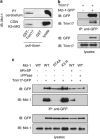Trim17-mediated ubiquitination and degradation of Mcl-1 initiate apoptosis in neurons
- PMID: 22976837
- PMCID: PMC3554334
- DOI: 10.1038/cdd.2012.124
Trim17-mediated ubiquitination and degradation of Mcl-1 initiate apoptosis in neurons
Abstract
Short-term proteasome inhibition has been shown to prevent neuronal apoptosis. However, the key pro-survival proteins that must be degraded for triggering neuronal death are mostly unknown. Here, we show that Mcl-1, an anti-apoptotic Bcl-2 family member, is degraded by the proteasome during neuronal apoptosis. Using primary cultures of cerebellar granule neurons deprived of serum and KCl, we found that ubiquitination and proteasomal degradation of Mcl-1 depended on its prior phosphorylation by GSK3, providing the first insight into post-translational regulation of Mcl-1 in neurons. In a previous study, we have reported that the E3 ubiquitin-ligase Trim17 is both necessary and sufficient for neuronal apoptosis. Here, we identified Trim17 as a novel E3 ubiquitin-ligase for Mcl-1. Indeed, Trim17 co-immunoprecipitated with Mcl-1. Trim17 ubiquitinated Mcl-1 in vitro. Overexpression of Trim17 decreased the protein level of Mcl-1 in a phosphorylation- and proteasome-dependent manner. Finally, knock down of Trim17 expression reduced both ubiquitination and degradation of Mcl-1 in neurons. Moreover, impairment of Mcl-1 phosphorylation, by kinase inhibition or point mutations, not only decreased ubiquitination and degradation of Mcl-1, but also blocked the physical interaction between Trim17 and Mcl-1. As this stabilization of Mcl-1 increased its neuroprotective effect, our data strongly suggest that Trim17-mediated ubiquitination and degradation of Mcl-1 is necessary for initiating neuronal death.
Figures








Similar articles
-
Trim17, a novel E3 ubiquitin-ligase, initiates neuronal apoptosis.Cell Death Differ. 2010 Dec;17(12):1928-41. doi: 10.1038/cdd.2010.73. Epub 2010 Jun 18. Cell Death Differ. 2010. PMID: 20559321 Free PMC article.
-
Control of neuronal apoptosis by reciprocal regulation of NFATc3 and Trim17.Cell Death Differ. 2015 Feb;22(2):274-86. doi: 10.1038/cdd.2014.141. Epub 2014 Sep 12. Cell Death Differ. 2015. PMID: 25215946 Free PMC article.
-
TRIM17 and TRIM28 antagonistically regulate the ubiquitination and anti-apoptotic activity of BCL2A1.Cell Death Differ. 2019 May;26(5):902-917. doi: 10.1038/s41418-018-0169-5. Epub 2018 Jul 24. Cell Death Differ. 2019. PMID: 30042493 Free PMC article.
-
To Ubiquitinate or Not to Ubiquitinate: TRIM17 in Cell Life and Death.Cells. 2021 May 18;10(5):1235. doi: 10.3390/cells10051235. Cells. 2021. PMID: 34069831 Free PMC article. Review.
-
Mcl-1 ubiquitination and destruction.Oncotarget. 2011 Mar;2(3):239-44. doi: 10.18632/oncotarget.242. Oncotarget. 2011. PMID: 21608150 Free PMC article. Review.
Cited by
-
Ubiquitination and deubiquitination of MCL1 in cancer: deciphering chemoresistance mechanisms and providing potential therapeutic options.Cell Death Dis. 2020 Jul 22;11(7):556. doi: 10.1038/s41419-020-02760-y. Cell Death Dis. 2020. PMID: 32699213 Free PMC article. Review.
-
TRIM17 contributes to autophagy of midbodies while actively sparing other targets from degradation.J Cell Sci. 2016 Oct 1;129(19):3562-3573. doi: 10.1242/jcs.190017. Epub 2016 Aug 25. J Cell Sci. 2016. PMID: 27562068 Free PMC article.
-
Gene losses may contribute to subterranean adaptations in naked mole-rat and blind mole-rat.BMC Biol. 2022 Feb 17;20(1):44. doi: 10.1186/s12915-022-01243-0. BMC Biol. 2022. PMID: 35172813 Free PMC article.
-
Saga of Mcl-1: regulation from transcription to degradation.Cell Death Differ. 2020 Feb;27(2):405-419. doi: 10.1038/s41418-019-0486-3. Epub 2020 Jan 6. Cell Death Differ. 2020. PMID: 31907390 Free PMC article. Review.
-
Drug Development Targeting the Ubiquitin-Proteasome System (UPS) for the Treatment of Human Cancers.Cancers (Basel). 2020 Apr 7;12(4):902. doi: 10.3390/cancers12040902. Cancers (Basel). 2020. PMID: 32272746 Free PMC article. Review.
References
Publication types
MeSH terms
Substances
LinkOut - more resources
Full Text Sources
Other Literature Sources
Molecular Biology Databases
Research Materials

